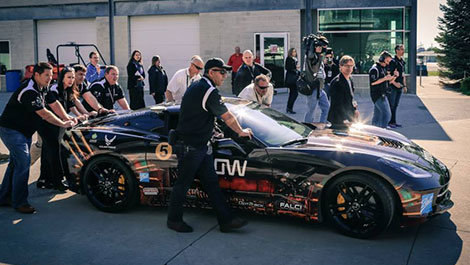May
20th
Stay connected Subscribe to our RSS feed
An off-season crash in 2000 rendered IndyCar driver, Sam Schmidt quadriplegic. Last Sunday, Schmidt took to the famed oval in a 2014 Chevrolet Corvette C7 Stingray adapted to his needs by Arrow Electronics, Inc.
Schmidt, today a successful IndyCar team owner, took the specially fitted Corvette up to 97 mph around the famous Brickyard.
Afterward, Schmidt used the words “exhilarating” and “unbelievable” to describe the feeling he said came after a nine month planning process.
Schmidt, who chairs the Sam Schmidt Paralysis Foundation, said the experience gave him hope that the technology utilized can be transferred to other applications to help many who are disabled.
The Corvette uses an advanced infrared camera system, a bite sensor and a GPS system to steer the car around the track. Schmidt averaged 73.712 mph on his 10-mile run, hitting 97 mph down the main straightaway.
A highly technical series of algorithms controls the vehicle. Four sensors mounted on the driver's helmet are connected to infrared cameras mounted on the dashboard. They detect his head tilt motions to aid in steering and acceleration. The driver also has a bite sensor device in his mouth, and the pressure of his bite helps control the car's braking and steering. The GPS keeps the car within 1 1/2 meters from the edge of the track.
“We get a ton of emails and correspondence from folks who maybe didn't want to leave their house or didn't know what they could do with their disability,” Schmidt declared.
“I'm a firm believer that everything happens for a reason. I think the reason I'm sitting here today without the use of arms and legs is so I can look somebody in the eye and say, ‘Get up off your butt and be a productive member of society.'
Schmidt, today a successful IndyCar team owner, took the specially fitted Corvette up to 97 mph around the famous Brickyard.
Afterward, Schmidt used the words “exhilarating” and “unbelievable” to describe the feeling he said came after a nine month planning process.
Schmidt, who chairs the Sam Schmidt Paralysis Foundation, said the experience gave him hope that the technology utilized can be transferred to other applications to help many who are disabled.
 |
| The specially equiped Corvette Sam Schmidt drove. (Photo: Sam Schmidt Motorsport) |
The Corvette uses an advanced infrared camera system, a bite sensor and a GPS system to steer the car around the track. Schmidt averaged 73.712 mph on his 10-mile run, hitting 97 mph down the main straightaway.
A highly technical series of algorithms controls the vehicle. Four sensors mounted on the driver's helmet are connected to infrared cameras mounted on the dashboard. They detect his head tilt motions to aid in steering and acceleration. The driver also has a bite sensor device in his mouth, and the pressure of his bite helps control the car's braking and steering. The GPS keeps the car within 1 1/2 meters from the edge of the track.
“We get a ton of emails and correspondence from folks who maybe didn't want to leave their house or didn't know what they could do with their disability,” Schmidt declared.
“I'm a firm believer that everything happens for a reason. I think the reason I'm sitting here today without the use of arms and legs is so I can look somebody in the eye and say, ‘Get up off your butt and be a productive member of society.'
 The latest auto news, reviews, prices, product and vehicle releases.
The latest auto news, reviews, prices, product and vehicle releases.